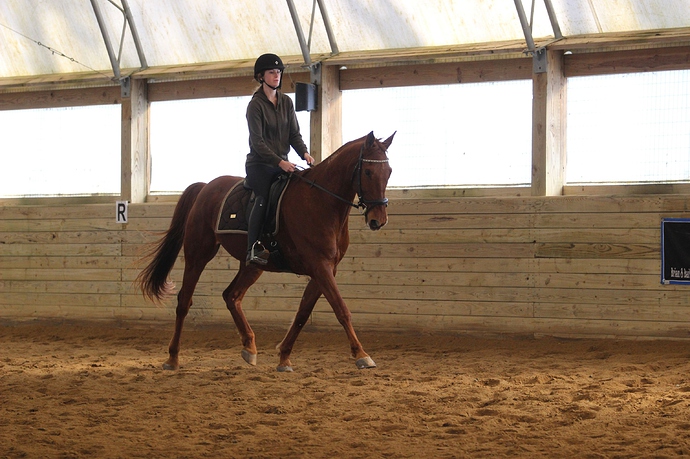You probably are not going to “like” what I have to say here… but perhaps it needs to be said.
Off the track SBs are not the best breed to purchase with the idea that you are going to make them into a dressage horse. Standardbreds, off the track or not, have many attributes that can be useful in many other disciplines and jobs for horses, it’s just that “dressage” isn’t really one of those things. Not to say that the basic training involved in basic dressage isn’t something that you can work on with your horse, it’s just that he has been selectively BRED to do things differently, and THAT is always going to be an issue for him. A problem for him and for you.
If you are looking for a competitive endurance long distance trail horse, they can be great for that. If you are looking for just a pleasure riding trail horse, or pack horse, they can be great for that. But the selective breeding in their family tree has attempted to “breed the canter out of them”, and breed the pace into them, so it will often be there, somewhere, should he get into a situation where he is stressed. As a competitive dressage horse, this will eliminate him from success. In many other disciplines, it may not.
I’m also going to go out on a limb here, and say that they are not well suited for jumping pursuits, although a few do jump to some extent. It’s not the JUMP itself that is the problem, it is the lack of a quality canter (again, because it has been purposely bred OUT of the breed) that is the issue. When the pressure goes on, in a one stride combination that is bigger than 3’ or 3’6", it is imperative that that one canter stride is a “quality” stride, to be able to jump out safely. It may be adequate 9 times out of 10, and jump out OK. But 1 time out of 10, you won’t, and it will be BAD.
If you wish to do a certain job with your horse, like “dressage”, choose a horse who is likely to have the skill set to be successful. If you love a standardbred, and want to ride him and give him a life after racing, choose a discipline where his background is going to help him be successful. Which doesn’t mean that you can’t or shouldn’t work on basic dressage principles to achieve these goals, because obviously, you should, just to make him be the best horse he can be for you. But don’t dream that he is going to be a dressage horse, because he probably isn’t.
Most SBs can canter, IF they are relaxed and responsive to your leg. But they will lose balance on turns easier than horses with a good natural canter will. If they become tense, they will lose balance at the canter. Because they are uncomfortable at this gait, it isn’t their forte. They will slip into a pace and lose the canter, should anything interrupt their concentration.
For many disciplines OTHER than competitive dressage or jumping events, a pace is fine and functional. You can ride him at the pace, it isn’t overly comfortable to sit on, but you can sit or post like at the trot. I had a SB as a lead pony at the racetrack for several years- he was fine at this job. He had raced for a LONG time, had been passed between a great many trainers and owners over his long racing career, and was well known across Western Canada. His pace was so deeply ingrained, that he had raced “free legged”, he did not wear hopples to train or to race, I heard. If you are a SB affectionado, his registered name was “Shadow’s Adios”. He was a blocky bodied bright chestnut, with a blaze… an oddity among SBs. And he paced most of the time during his time at the TB racetrack. He paced as the TB galloped beside him. He was a character. His suspensories had stopped his race career, and they were something I always kept an eye on, but he never went lame on them when I had him. They are VERY tough horses. I gave him away as a recreational trail riding horse when I got tired of being jarred with his pacing gait. He had been given to me, so I gave him to another owner who I felt was better suited to him as he aged. But no one ever tried to make him into a dressage horse.




